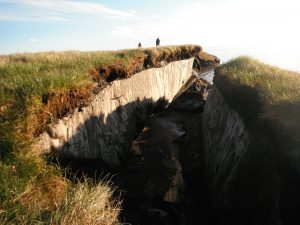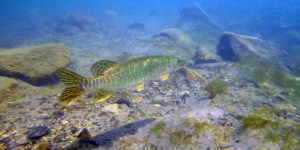Thawing Arctic permafrost could release massive amounts of mercury
Indigenous groups who rely on hunting and fishing could be especially at risk.

First, there was the “carbon bomb.” Now add a mercury bomb to the scary risks posed by permafrost thaw.
New research shows that permafrost soils hold massive quantities of mercury — nearly twice as much as is held in all other soils in the world, plus the mercury in the oceans and the atmosphere — and that the newly measured mercury is in danger of being released as permafrost thaws.
“It is another bomb,” said Paul Shuster, a U.S. Geological Survey hydrologist based in Colorado and lead author of a newly published study that describes the findings.
The study, published in the journal Geophysical Research Letters, is based on measurements of mercury and carbon in permafrost soil cores drilled in Alaska between 2004 and 2012. Those measurements were used to calculate total mercury contents in northern permafrost soil — approximately 793 gigagrams, or more than 15 million gallons, about 10 times the total mercury emissions produced by human activities over the last 30 years.
It is the first calculation of permafrost mercury to be published.

The mercury sequestration parallels the sequestration of carbon in permafrost. Scientists estimate the northern permafrost, which is packed with ancient plants and other organic material, holds about twice as much carbon as is in the Earth’s atmosphere, though exact measurements are unclear. As permafrost thaws, the stored carbon is released. Already, scientists have concluded that the tundra on Alaska’s North Slope and other parts of the Arctic is a net carbon emitter and no longer the carbon sink it was in the past.
How quickly that carbon will be released is not yet clear. One 2015 study predicts a steady release through the end of the century rather than a sudden pulse or “carbon bomb,” but whatever the rate, carbon released from permafrost is expected to add to the Earth-warming greenhouse gases.
Permafrost thaw will similarly transform the Arctic from mercury store to mercury emitter, affecting the planet’s mercury cycle, Schuster said. “The more it thaws, the more we move from sink to source,” he said.
The rate of expected mercury release is not yet known, but it is likely to parallel that of the carbon release, he said. By the end of the century, 30 percent to 90 percent of carbon now held in permafrost is expected to be emitted through thaw, he said.
Elemental mercury emitted by thawed permafrost could become dangerous to human and animal health. If mercury is altered through biological processes into methylmercury, serious problems for wildlife and people could result.
For Alaska Natives who live close to thawing permafrost — and who rely on fish from local waters — the results of the new study are troubling, one official said in a statement released by the American Geophysical Union, the organization that publishes Geophysical Research Letters.
“Rural communities in Alaska and other northern areas have a subsistence lifestyle, making them vulnerable to methylmercury contaminating their food supply,” Edda Mutter, science director for the Yukon River Inter-Tribal Watershed Council, said in the statement. “Food sources are important to the spiritual and cultural health of the natives, so this study has major health and economic implications for this region of the world.”
The USGS has a broad research program examining climate change effects on the Yukon River basin, including effects of permafrost thaw on mercury levels. And the Alaska Department of Health and Social Services monitors mercury levels in fish from the Alaska waters.
Fish species have varying levels of vulnerability to methylmercury. Fortunately for many indigenous people in Alaska, salmon — a dietary staple — is less likely to accumulate methylmercury, Schuster said. But pike, another important species in indigenous diets, is more susceptible, he said.
Yereth Rosen is a 2018 Alicia Patterson Foundation fellow.